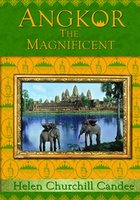Candee's Angkor
 Later this year, or early next, a modern and expanded edition of one of the most popular accounts of the exotic, and then largely unknown, temples of Cambodia in Helen Churchill Candee's Angkor The Magnificent, will be published by DatASIA Inc. It was due out a few months ago but a fire in the home of CEO Kent Davis destroyed some of the graphics and other material, causing a delay in printing. Originally published in 1924, it brought to life the vast jungle edifices of Angkor and their mysteries through the eyes of this intrepid woman explorer.
Later this year, or early next, a modern and expanded edition of one of the most popular accounts of the exotic, and then largely unknown, temples of Cambodia in Helen Churchill Candee's Angkor The Magnificent, will be published by DatASIA Inc. It was due out a few months ago but a fire in the home of CEO Kent Davis destroyed some of the graphics and other material, causing a delay in printing. Originally published in 1924, it brought to life the vast jungle edifices of Angkor and their mysteries through the eyes of this intrepid woman explorer.In addition, Candee was a survivor of history’s most infamous maritime disaster, the sinking of the Titanic, one adventure among many for the Washington, D.C. society leader and interior decorator who turned more and more to the joys of writing and the thrill of travel to the foreign lands that intrigued her. On her journeys of discovery, Helen Candee walked with kings, presidents, the wealthy and powerful – entertaining, educating and influencing them along the way. Yet her outlook was democratic, her approach spiritual, her love for people of all races genuine. A champion of female equality, she was yet quintessentially feminine – as bold as she was beautiful, she charmed while she shocked. Candee’s vision and talent were never melded with greater impact than in the pioneering work she accomplished after traveling the Far East with her keen sense of detail, inquisitive mind, and respect for a culture that enchanted her. The result of her study, Angkor the Magnificent, is more than a tale of early 20th century Asian travel. Candee’s observations are enlightening, elegant and witty as she relates the history and context of Angkor’s ancient monuments. Thanks to her inspired hand, the world has one of the first significant works on Cambodia in the English language.
The book will include Candee’s complete original account of Southeast Asian travel, a biography of the explorer by Randy Bryan Bigham and more than 120 illustrations of Cambodia and the author. Candee’s personal account of the Titanic disaster is also included, as is a bibliography and index.
Here's an excerpt from Randy Bryan Bigham's biography of Candee called Life's Decor:
Travel for Helen Candee in the early 1920s increasingly meant Japan, China and the exotic Far Eastern lands of Indonesia and Cambodia. The latter was a chief draw, and in her sixth book, Angkor the Magnificent , now a classic travelogue, Helen's facility for words found inspiration in the mysterious, half-hidden temples and palaces, hanging gardens, sculpture and stonework of the ancient “Wonder City." In her book, the beauty and symbolism of the architecture of the temple of Angkor Wat came in for rapturous praise: One can never look upon the ensemble of the Wat without a thrill, a pause, a feeling of being caught up to the heavens. Perhaps it is the most impressive sight in the world of edifices.
The fascinating ruins of Angkor and their Eden-like environs had only been known to Westerners for fifty years, and weren't widely explored or photographed before Candee's ambitious study. Her book, published by Stokes in 1924, was the work Helen was most proud of. It also brought her the most acclaim. She was commanded to give a private reading of Angkor the Magnificent to King George and Queen Mary and was afterwards asked to Their Majesties' annual garden party at Holyroodhouse, being one of only a few Americans invited. Helen was even decorated by the King of Cambodia in a native ceremony. Captivated by the region, its riches and its people, Helen was pleased that the success of Angkor the Magnificent allowed her to focus on Asia in a series of articles and short stories for newspaper syndication the following year, as well as a special feature for Art and Archeology Magazine.


0 Comments:
Post a Comment
<< Home